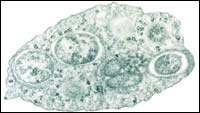

Wolbachia have a thing against males. A member of one of the most diverse groups of bacteria, called Proteobacteria, this parasitic “endosymbiont” lives inside the reproductive cells of a wide variety of the nearly one million species of arthropods, including insects, spiders, and crustaceans.
Wolbachia’s effects range from beneficial to pathological, but if the host is male, the infection often turns out badly. The reason is the Wolbachia are transmitted through females, and to increase the chances of being passed on from one generation to the next, the bacterium has developed a number of strategies to rid the population of males, or even to convert them to females. As far as Wolbachia are concerned, males are irrelevant.
The biochemical mechanisms that trigger different strategies in different hosts are unclear, however, in part because it has so far been impossible to grow sufficient quantities of these bacteria outside their host. But now that Scott O’Neill, Jonathan Eisen, and colleagues have sequenced the complete genome of one strain of Wolbachia pipientis, scientists are already gaining new insight into the biology and evolution of Wolbachia-host interactions.
The work is also likely to have practical applications – it has been proposed that Wolbachia could be used to control insect pests. It might also provide a new approach to the control of human and animal filariasis (diseases such as elephantiasis), since the worms that cause filariasis require the endosymbiotic Wolbachia for survival.
Citation: Wu M, Sun LV, Vamathevan J, Riegler M, Deboy R, et al. (2004) Phylogenomics of the Reproductive Parasite Wolbachia pipientis wMel: A Streamlined Genome Overrun by Mobile Genetic Elements. PLoS Biol: e69 DOI: 10.1371/journal.pbio.0020069












